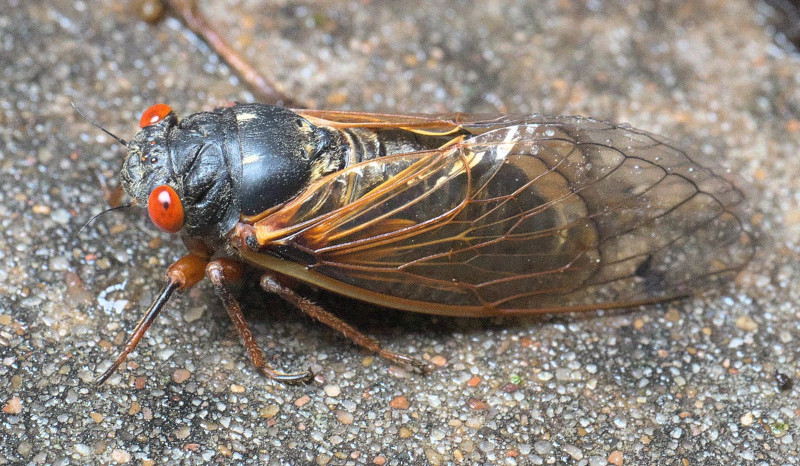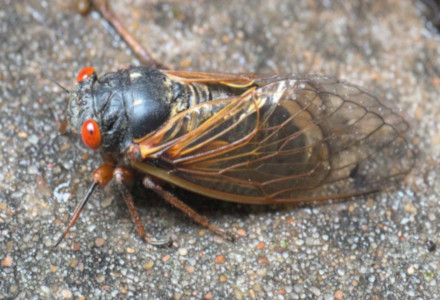
Magicicada Facts
- Most notably, the term of Magicicada actually refers to either of two separate but closely related varieties of periodical cicadas. In a truly extraordinary adaptation of Nature, the two members of this genus evolved an astounding instinctive trait.
- That holds true due to the unbelievable fact that these actually represent 13 and 17-year cycle periodical cicadas. Tthe insects additionally possess yet another remarkable behavioral pattern. In fact, they spend most of their lives underground.
- There, it feeds on the fluids from the roots of deciduous trees native to the part of the world it inhabits. After either of the two time periods, the mature nymphs emerge at random locations. This action occurs in tandem with others, in incredible numbers.
- After such an extended developmental phase, the next chapter of the lives of these invertebrates seems quite brief in comparison. To be precise, the adult specimens of the amazing invertebrate remain active for only about 4-6 weeks.
- Fascinatingly, the cycle of life of the Magicicada actually becomes complete within two months of the original emergence. By that time the eggs have been laid and the adult cicadas vanish beneath the surface, to begin the cycle again.
Related Articles
Rainbow Grasshopper Lovebug Iridescent Bark Mantis
Magicicada Physical Description
Confusing matters somewhat, both known species of the remarkable Magicicada display almost the exact same physical appearance. Part of this extremely distinctive look is quite readily apparent to the observer. This remains the startling red eyes possessed by the creatures.
This display, consequently, starkly contrasts with that of the completely black thorax. The wings of both forms of the awesome Magicicada further typically appear translucent, in sharp contrast. These also display bright orange colored veins.
The underside of the abdomen also presents as either black, orange, or striped with orange and black. This pattern holds for the great majority of specimens. Which pattern individuals display also depends on the individual species of this insect.
The adults attain an impressive size. In fact, these average about 0.9-1.3 in (2.4-3.3 cm) in length. This makes them slightly smaller than the annual cicada species living in the same regions. The species also displays sexual dimorphism. Mature females grow slightly larger than males.
- Kingdom: Animalia
- Phylum: Arthropoda
- Class: Insecta
- Order: Hemiptera
- Family: Cicadidae
- Genus: Magicicada
Magicicada Distribution, Habitat, and Ecology
Quite unfortunately for those who appreciate the beauty of Nature, both forms of the Magicicada inhabit a restricted portion of the globe. This holds true because of the fact that this genus only inhabits a small, and concentrated, section of North America.
Even more precisely, though, these incredible insects only appear across areas of the eastern, upper mid-western, and Great Plains states within the United States. Within this region of the country, however, it inhabits virtually all types of habitats.
This occurs because nymphs spend nearly their entire lives underground. That’s true regardless of which variety the individual forms a member of. The nymphs also undergo a total of 5 distinct developmental stages in their lives beneath the surface.
The difference in the two different life cycles is the time it takes the second stage to mature. While underground, the nymphs move ever deeper below ground, to feed on larger roots. However, these do eventually emerge, at the end of their respective cycles.
The nymphs also typically emerge at a very specific time. This consists of a spring evening. In most years, this will occur in either late April or early May in far southern states. In the far northern states, though, it usually happens in late May or early June.
Emerging nymphs climb to a suitable place on the nearby vegetation to complete their transformation. The astonishing numbers of Magicicada will then molt one final time, and then spend about six days in the leaves waiting for the exoskeletons to finish hardening.
The short adult life cycle of the creatures has one purpose. That’s to reproduce, during which time they sing in a chorus that can be nearly deafening. In point of fact, these often number more than 1.5 million individuals per acre (0.4 hectares).
Species Sharing Its Range
Check out our other articles on 5 Rare Mind-Blowing Cloud Types, Wadi Rum, Kauri Tree, Laotian Giant Flying Squirrel, Guinan cock-of-the-rock, Komodo Dragon

